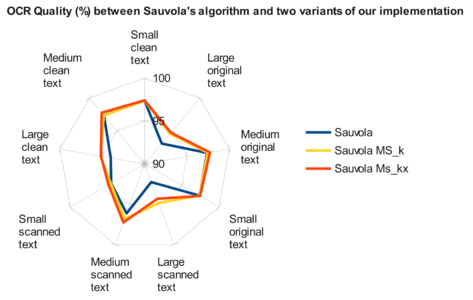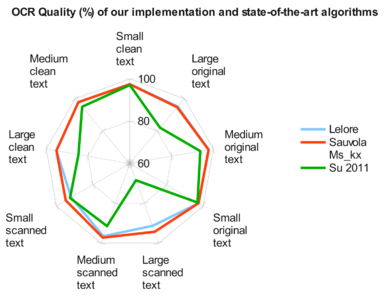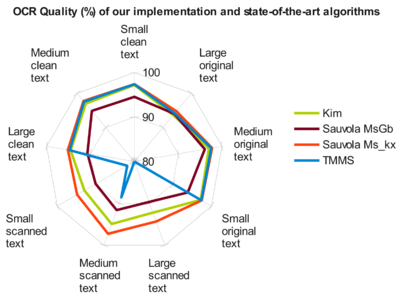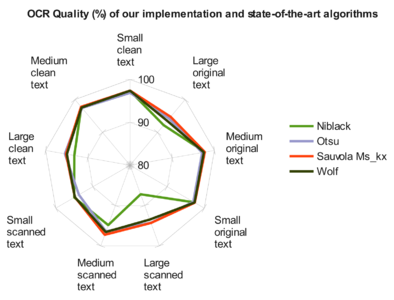Difference between revisions of "Publications/lazzara.13.ijdar"
From LRDE
| Line 7: | Line 7: | ||
| volume = 17 |
| volume = 17 |
||
| number = 2 |
| number = 2 |
||
| − | | pages = |
+ | | pages = 105–123 |
| publisher = Springer Berlin Heidelberg |
| publisher = Springer Berlin Heidelberg |
||
| abstract = This work is focused on the most commonly used binarization method: Sauvola's. It performs relatively well on classical documents. However, three main defects remain: the window parameter of Sauvola's formula do not fit automatically to the content; it is not robust to low contrasts; it is non-invariant with respect to contrast inversion. Thus, on documents such as magazines, the content may not be retrieved correctly which is crucial for indexing purpose. In this paper, we describe how to implement an efficient multiscale implementation of Sauvola's algorithm in order to guarantee good binarization for both small and large objects inside a single document without adjusting the window size to the content. We also describe on how to implement it in an efficient way, step by step. Pixel-based accuracy and OCR evaluations are performed on more than 120 documents. This implementation remains notably fast compared to the original algorithm. For fixed parameters, text recognition rates and binarization quality are equal or better than other methods on small and medium text and is significantly improved on large text. Thanks to the way it is implemented, it is also more robust on textured text and on image binarization. This implementation extends the robustness of Sauvola's algorithm by making the results almost insensible to the window size whatever the object sizes. Its properties make it usable in full document analysis toolchains. |
| abstract = This work is focused on the most commonly used binarization method: Sauvola's. It performs relatively well on classical documents. However, three main defects remain: the window parameter of Sauvola's formula do not fit automatically to the content; it is not robust to low contrasts; it is non-invariant with respect to contrast inversion. Thus, on documents such as magazines, the content may not be retrieved correctly which is crucial for indexing purpose. In this paper, we describe how to implement an efficient multiscale implementation of Sauvola's algorithm in order to guarantee good binarization for both small and large objects inside a single document without adjusting the window size to the content. We also describe on how to implement it in an efficient way, step by step. Pixel-based accuracy and OCR evaluations are performed on more than 120 documents. This implementation remains notably fast compared to the original algorithm. For fixed parameters, text recognition rates and binarization quality are equal or better than other methods on small and medium text and is significantly improved on large text. Thanks to the way it is implemented, it is also more robust on textured text and on image binarization. This implementation extends the robustness of Sauvola's algorithm by making the results almost insensible to the window size whatever the object sizes. Its properties make it usable in full document analysis toolchains. |
||
Revision as of 18:51, 4 January 2018
- Authors
- Guillaume Lazzara, Thierry Géraud
- Journal
- International Journal of Document Analysis and Recognition (IJDAR)
- Type
- article
- Publisher
- Springer Berlin Heidelberg
- Projects
- Olena
- Date
- 2013-04-25
Abstract
This work is focused on the most commonly used binarization method: Sauvola's. It performs relatively well on classical documents. However, three main defects remain: the window parameter of Sauvola's formula do not fit automatically to the content; it is not robust to low contrasts; it is non-invariant with respect to contrast inversion. Thus, on documents such as magazines, the content may not be retrieved correctly which is crucial for indexing purpose. In this paper, we describe how to implement an efficient multiscale implementation of Sauvola's algorithm in order to guarantee good binarization for both small and large objects inside a single document without adjusting the window size to the content. We also describe on how to implement it in an efficient way, step by step. Pixel-based accuracy and OCR evaluations are performed on more than 120 documents. This implementation remains notably fast compared to the original algorithm. For fixed parameters, text recognition rates and binarization quality are equal or better than other methods on small and medium text and is significantly improved on large text. Thanks to the way it is implemented, it is also more robust on textured text and on image binarization. This implementation extends the robustness of Sauvola's algorithm by making the results almost insensible to the window size whatever the object sizes. Its properties make it usable in full document analysis toolchains.
Documents
Resources
- Source code (under GPL v2 licence) :
git clone git://git.lrde.epita.fr/olena -b papers/lazzara.13.ijdar && cd olena/scribo/scribo/binarization
- Evaluation outputs (detailed hereinafter).
- Evaluation outputs (detailed hereinafter).
This algorithm is also part of the generic image processing platform Olena
Outputs and Scores on classical datasets
Pixel-based Accuracy Evaluation
1. Sauvola MS_k
| Dataset | Recall | p-Recall | Precision | F-measure (± std) | p-FM (± std) | PSNR | DRD | MPM | Outputs | |
|---|---|---|---|---|---|---|---|---|---|---|
| DIBCO'09 | 88.4088 | 76.3713 | 78.08 (± 18.498) | 15.2386 | 14.084 | 4.5068 | Outputs | Outputs | ||
| H-DIBCO'10 | 52.9688 | 63.2666 | 83.6741 | 61.17 (± 25.326) | 69.45 (± 26.880) | 14.72 | 9.510 | 1.82 | Outputs | Outputs |
| DIBCO'11 | 79.3667 | 83.9283 | 79.31 (± 11.711) | 15.33 | 8.156 | 11.5355 | Outputs | Outputs | ||
| H-DIBCO'12 | 66.5586 | 73.3397 | 88.0996 | 69.56 (± 18.316) | 74.78 (± 17.063) | 15.12 | 10.368 | 2.79 | Outputs | Outputs |
| CMATERdb 6.1 | 82.1535 | 95.2257 | 87.20 (± 8.872) | 17.10 | 5.265 | 0.2405 | Outputs | Outputs |
2. Sauvola MS_kx
| Dataset | Recall | p-Recall | Precision | F-measure (± std) | pF-measure (± std) | PSNR | DRD | MPM | Outputs | |
|---|---|---|---|---|---|---|---|---|---|---|
| DIBCO'09 | 95.1858 | 69.2059 | 76.85 (± 20.277) | 14.52 | 18.516 | 8.9698 | Outputs | Outputs | ||
| H-DIBCO'10 | 77.1109 | 88.8740 | 88.3846 | 80.03 (± 9.269) | 87.07 (± 10.262) | 16.36 | 6.896 | 3.42 | Outputs | Outputs |
| DIBCO'11 | 89.7931 | 75.0818 | 79.70 (± 12.689) | 14.91 | 11.669 | 20.4354 | Outputs | Outputs | ||
| H-DIBCO'12 | 83.7305 | 84.6084 | 91.8082 | 81.77 (± 8.765) | 86.41 (± 9.768) | 16.51 | 8.369 | 5.34 | Outputs | Outputs |
| CMATERdb 6.1 | 91.4903 | 91.6986 | 91.34 (± 4.232) | 18.18 | 3.775 | 0.8408 | Outputs | Outputs |
These evaluation shows that our multiscale algorithm is equivalent to the classical Sauvola on historical documents. This result was expected as this algorithm is designed for magazines.
Outputs and Scores on LRDE's Document Binarization Dataset
Results have been produced using LRDE's Document Binarization Dataset (DBD) version 1.0.
Please refer to the article to know how they have been produced and what are the different document qualities.
Binary Outputs
| Method | Clean documents | Scanned documents | Original documents | |||
|---|---|---|---|---|---|---|
| Sauvola | Outputs | Outputs | Outputs | Outputs | Outputs | Outputs |
| Sauvola MS_kx | Outputs | Outputs | Outputs | Outputs | Outputs | Outputs |
| Sauvola MS_k | Outputs | Outputs | Outputs | Outputs | Outputs | Outputs |
| Wolf | Outputs | Outputs | Outputs | Outputs | Outputs | Outputs |
| Otsu | Outputs | Outputs | Outputs | Outputs | Outputs | Outputs |
| Niblack | Outputs | Outputs | Outputs | Outputs | Outputs | Outputs |
| Kim | Outputs | Outputs | Outputs | Outputs | Outputs | Outputs |
| TMMS | Outputs | Outputs | Outputs | Outputs | Outputs | Outputs |
| Sauvola MsGb | Outputs | Outputs | Outputs | Outputs | Outputs | Outputs |
| Su 2011 | Outputs | Outputs | Outputs (1) | Outputs (1) | Outputs (2) | Outputs (2) |
| Lelore | Outputs | Outputs | Outputs | Outputs | Outputs | Outputs |
(1) Due to program crashes, one output image is missing (page 103).
(2) Due to program crashes, one output image is missing (pages 43, 46, 80, 90, 94, 151)
Pixel-based Accuracy Evaluation
| Method | Precision | Recall | F-Measure | Time (s) |
|---|---|---|---|---|
| Sauvola MS_kx | 0.97 | 0.94 | 94.97 | 170 |
| Lelore | 0.99 | 0.88 | 92.9 | 1625 |
| Sauvola MS_k | 0.97 | 0.89 | 92.10 | 170 |
| TMMS | 0.90 | 0.95 | 91.97 | 250 |
| Wolf | 0.99 | 0.85 | 91.38 | 125 |
| Otsu | 0.98 | 0.84 | 90.33 | 67 |
| Sauvola | 0.99 | 0.82 | 89.67 | 155 |
| Kim | 0.99 | 0.82 | 89.34 | 260 |
| Sauvola MsGb | 0.99 | 0.82 | 89.29 | 31h |
| Niblack | 0.89 | 0.91 | 88.79 | 170 |
| Su 2011 | 0.98 | 0.80 | 87.3 | 8800 |
This evaluation shows that state-of-the-art implementations, like Su 2011, do not handle magazines correctly. The main issues encountered by all the methods are related to large objects and the fact that parameters do not fit to the contents. Our multiscale approach succeeds in improving classical Sauvola algorithm results because large objects are correctly retrieved. The computation time corresponds to the approximate total time needed to compute the whole 125 document binarization. All time measures have been performed on the same computer with an Intel Xeon W3520@2,67Ghz with 6GB of RAM, except for Lelore' method of which time was measured on an Intel i7 860@2,8Ghz.
OCR-based Evaluation
| Method | OCR error (%) | ||||||||
|---|---|---|---|---|---|---|---|---|---|
| Set → | Clean documents | Scanned documents | Original documents | ||||||
| Subset → | S | M | L | S | M | L | S | M | L |
| Sauvola | 2.62 | 2.61 | 6.00 | 5.49 | 3.87 | 7.75 | 2.62 | 2.61 | 6.90 |
| Sauvola Ms_kx | 2.59 | 2.21 | 4.83 | 5.14 | 2.74 | 5.68 | 2.54 | 2.28 | 5.25 |
| Sauvola Ms_k | 2.64 | 2.60 | 4.78 | 5.44 | 3.20 | 5.15 | 2.64 | 2.53 | 5.41 |
| Wolf | 2.60 | 2.42 | 5.04 | 5.14 | 3.43 | 6.53 | 2.61 | 2.52 | 6.48 |
| Otsu | 3.09 | 2.55 | 4.56 | 6.23 | 3.58 | 5.73 | 2.95 | 2.90 | 5.79 |
| Niblack | 2.68 | 2.28 | 6.79 | 4.96 | 5.15 | 12.79 | 2.68 | 2.28 | 7.80 |
| Kim | 2.79 | 3.01 | 5.47 | 7.03 | 5.08 | 7.80 | 2.78 | 3.01 | 6.37 |
| TMMS | 2.61 | 2.43 | 5.25 | 18.17 | 11.44 | 54.83 | 2.61 | 2.45 | 5.84 |
| Sauvola MsGb | 5.45 | 5.14 | 9.29 | 9.49 | 8.40 | 10.35 | 6.14 | 3.93 | 6.00 |
| Su 2011 | 2.95 | 5.01 | 15.39 | 7.42 | 8.54 (3) | 31.58 (3) | 3.09 (4) | 6.24 (4) | 17.87 (4) |
| Lelore | 2.46 | 2.21 | 4.88 | 8.01 | 3.44 | 8.65 | 2.51 | 2.22 | 4.88 |
(3) Due to program crashes, those scores do not include the results of 2 medium text lines out of 320 and of 57 small text lines out of 9551.
(4) Due to program crashes, those scores do not include the results of 9 large text lines out of 123, 9 medium text lines out of 320, 432 small text lines out of 9551.
References
- [Fabrizio2009] J. Fabrizio, B. Marcotegui, M. Cord, Text segmentation in natural scenes using Toggle-Mapping, in the proceedings of the International Conference on Image Processing (ICIP), 2009, pp.2373-2376. DOI: 10.1109/ICIP.2009.5413435
- [Farrahi2010] R. Farrahi Moghaddam, M. Cheriet, A multi-scale framework for adaptive binarization of degraded document images, Pattern Recognition 43, 2010, 2186-2198. DOI: 10.1016/j.patcog.2009.12.024 website.
- [Kim2004] In-Jung Kim, Multi-window binarization of camera image for document recognition, in the proceedings of the International Workshop on Frontiers in Handwriting Recognition, 2004, pp. 323- 327. DOI: 10.1109/IWFHR.2004.70
- [Lelore2011] T. Lelore, F. Bouchara, Super-resolved binarization of text based on the FAIR algorithm, in the proceedings of the International Conference on Document Analysis and Recognition, 2011, pp.839-843. DOI: 10.1109/ICDAR.2011.172
- [Niblack1985] W. Niblack, An introduction to digital image processing, Strandberg Publishing Company Birkeroed, 1985, ISBN: 87-872-0055-4.
- [Otsu1975] N. Otsu, A threshold selection method from gray-level histograms, IEEE Transactions on Systems, Man and Cybernetics, Vol. 9, No. 1., January 1979, pp. 62-66.
- [Sauvola2000] J. Sauvola, M. Pietikäinen, Adaptive document image binarization, Pattern Recognition, Volume 33, Issue 2, February 2000, Pages 225-236, ISSN 0031-3203, DOI: 10.1016/S0031-3203(99)00055-2.
- [Su2011] B. Su, S. Lu, C. L. Tan, Binarization of historical document images using the local maximum and minimum, in the proceedings of the International Workshop on Document Analysis Systems, pages 159-166, 2010, ISBN: 978-1-60558-773-8, DOI: 10.1145/1815330.1815351 website.
- [Wolf2004] C. Wolf, J.-M. Jolion, extraction and recognition of artificial text in multimedia documents, Pattern Analysis & Applications, Springer London, Issn: 1433-7541, pp.309-326, volume: 6, issue: 4, DOI: 10.1007/s10044-003-0197-7.
Bibtex (lrde.bib)
@Article{ lazzara.13.ijdar,
author = {Guillaume Lazzara and Thierry G\'eraud},
title = {Efficient Multiscale {S}auvola's Binarization},
journal = {International Journal of Document Analysis and Recognition
(IJDAR)},
year = 2014,
month = jun,
volume = 17,
number = 2,
pages = {105--123},
publisher = {Springer Berlin Heidelberg},
doi = {10.1007/s10032-013-0209-0},
abstract = {This work is focused on the most commonly used
binarization method: Sauvola's. It performs relatively well
on classical documents. However, three main defects remain:
the window parameter of Sauvola's formula do not fit
automatically to the content; it is not robust to low
contrasts; it is non-invariant with respect to contrast
inversion. Thus, on documents such as magazines, the
content may not be retrieved correctly which is crucial for
indexing purpose. In this paper, we describe how to
implement an efficient multiscale implementation of
Sauvola's algorithm in order to guarantee good binarization
for both small and large objects inside a single document
without adjusting the window size to the content. We also
describe on how to implement it in an efficient way, step
by step. Pixel-based accuracy and OCR evaluations are
performed on more than 120 documents. This implementation
remains notably fast compared to the original algorithm.
For fixed parameters, text recognition rates and
binarization quality are equal or better than other methods
on small and medium text and is significantly improved on
large text. Thanks to the way it is implemented, it is also
more robust on textured text and on image binarization.
This implementation extends the robustness of Sauvola's
algorithm by making the results almost insensible to the
window size whatever the object sizes. Its properties make
it usable in full document analysis toolchains.}
}




